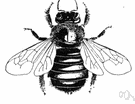carpenter bee
Also found in: Thesaurus, Encyclopedia, Wikipedia.
carpenter bee
n.
Any of various solitary bees of the genus Xylocopa that bore tunnels into wood to lay their eggs.
American Heritage® Dictionary of the English Language, Fifth Edition. Copyright © 2016 by Houghton Mifflin Harcourt Publishing Company. Published by Houghton Mifflin Harcourt Publishing Company. All rights reserved.
carpenter bee
n
(Animals) any large solitary bee of the genus Xylocopa and related genera that lays its eggs in tunnels bored into wood or in plant stems: family Apidae
Collins English Dictionary – Complete and Unabridged, 12th Edition 2014 © HarperCollins Publishers 1991, 1994, 1998, 2000, 2003, 2006, 2007, 2009, 2011, 2014
car′penter bee`
n.
any of several solitary bees of the family Apidae that build nests by boring tunnels in wood.
[1830–40]
Random House Kernerman Webster's College Dictionary, © 2010 K Dictionaries Ltd. Copyright 2005, 1997, 1991 by Random House, Inc. All rights reserved.
ThesaurusAntonymsRelated WordsSynonymsLegend:
Switch to new thesaurus
| Noun | 1. |  carpenter bee - large solitary bee that lays eggs in tunnels bored into wood or plant stems carpenter bee - large solitary bee that lays eggs in tunnels bored into wood or plant stemsbee - any of numerous hairy-bodied insects including social and solitary species genus Xylocopa, Xylocopa - carpenter bees |
Based on WordNet 3.0, Farlex clipart collection. © 2003-2012 Princeton University, Farlex Inc.